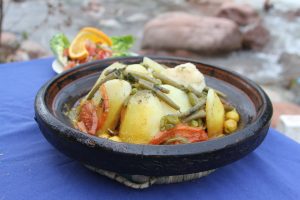Moroccan Vegetable Tagine au légumes is a vegetarian Moroccan stew that is fragrant with toasty spices. You can use any vegetables you have on hand; just be sure to season them well.
This is one of those rare finds that almost everybody can enjoy. In addition to being delicious, it is also meatless, gluten-free, low-carb, low-calorie, and very satisfying. But wait, it gets better: it’s also cruelty-free for vegans. The vegetarians win!
Moroccan Vegetable Tagine
Last week I polled RecipeTin Eats followers to find out what sorts of dishes they want to see more of in 2014. Meatless, low-caloric, and low-carb options were the most in-demand varieties.
However, it is still ridiculously delicious. A one-pot, simple, and fast method of preparation would be ideal, but if it were also possible… OK, that’s a nice thought.
Since the recipe takes around 45 minutes to simmer the veggies so that they are delicate and ready to soak up all the delicious flavors, I wouldn’t call it fast, but it is quite simple.
Tagine is a typical Moroccan stew that is prepared in a tagine. Steam circulates while cooking in this earthenware pot with a cone-shaped lid, and the flavorful condensation drips back down into the stew.
Tagine de légumes – ingrédients
You can tell your taste buds are in for a treat from the abundance of spices used. In contrast, isn’t it good that all of these seasonings can be found in any supermarket?
You can taste the spices, but there isn’t that “kapow!” factor you get from authentic Indian curries. It has the feel of a warm spice blend.
You can omit the cayenne if you like a milder dish.
Also, for the Moroccan Vegetable Tagine, you’ll need the following. Feel free to improvise with any vegetables you have on hand; this recipe is all about making do with what you have.
Look at what I used!
- The chickpeas in this recipe are the only source of starch, and they give a satisfyingly nutty texture and a lot of weight. Use any other type of beans in their place.
- Zest and juice from a lemon add a bright final note.
- The typical suspects for flavor bases, onions and garlic are always good to have on hand.
- Butternut squash, bell peppers, green beans, eggplant, cauli florets, and tomatoes are some of the vegetables featured here (which sort of become part of the sauce). This dish is wonderfully cost-effective due to the attractive combination of colors and textures found in seasonal ingredients available at the same time.
Method for Preparing Moroccan Vegetable Tagine
Vegetables are pan-roasted to develop color and flavor before being simmered in a broth that has been strongly spiced. For the simple reason that color equals flavor, as I often say.
- To begin, sauté some garlic and onions (our flavor base, as mentioned).
- To add some color and flavor, pan-roast the vegetables one by one. We only lightly color them, not all the way through.
- Keep the tomato in the microwave for a minute. All the delicious bits stuck to the bottom of the pan from sautéing the vegetables can now be incorporated into our stew, as the pan has been properly deglazed. Then, after a minute, add spices and allow them to release their aroma and flavor.
- Put the veggies back in the pot and cover with water. (You read that correctly; it’s water, not stock. Real tagines have no added seasonings or spices. Keep in mind that the vegetables will sink to the bottom of the pot while they cook, so the water level should be just below where the vegetables would otherwise be. Overwatering the sauce will result in a bland flavor.
- Bring to a low boil.
- Put it in a covered baking dish and bake for 30 minutes. Because it doesn’t require any stirring, this is the simplest method. You may also use a stovetop simmering method, but be sure to stir carefully to prevent the vegetables from becoming mushy.
- Green beans and chickpeas can be added to the pot, and the liquid can be reduced by simmering for 15 minutes. The soft, somewhat broken-down pumpkin and cauliflower at this point aid in thickening the liquid. A brothy consistency is preferable but not required. Just take my word for it: you’ll want some of that broth.
- When finished, add the lemon juice and zest. As with many other dishes, from Lentil Soup to Magic Broccoli (so-called because it is so easy to make but so delicious), a dash of something fresh at the end can do wonders to brighten and enliven the whole thing.
How to Complement Moroccan Vegetable Tagine
Serve with couscous for an authentic Moroccan meal. I decided to make a separate post about this because it’s such a useful and fast no-cook side dish for all sorts of meals, not just Moroccan and Middle Eastern fare.
Plain couscous would be fine with all the flavors in the tagine, but I never say no to a little extra flavor with chopped herbs, dried fruit, or nuts.
Alternatives:
- As a main dish on its own, this is akin to a substantial stew with lots of chunky ingredients.
- Any kind of rice (white, brown, basmati, lemon-flavored would also be lovely).
- Quinoa.
- Cauliflower rice (to fill you up with a lot of healthy fats and little carbohydrates and calories!).
- Dipping flatbreads, either homemade or purchased.
Instructions
- Bringing together the Tagine Spice Mix components.
- Turn the oven temperature up to 180 degrees Celsius (around 350 degrees Fahrenheit).
- In a large, heavy-bottomed pot, heat 1 tablespoon of oil over medium heat. Throw in some garlic and onion, let them sweat for about a minute and a half, then transfer everything to a big bowl. The last of the garlic should be scraped out of the pan (to prevent it from burning).
- Stir the pumpkin or squash for 3 minutes, or until it is lightly browned on most sides. Put it back in the same bowl.
- Include 2 tablespoons of olive oil. Toss eggplant in oil and cook for 3 minutes, or until golden on most sides.
If the saucepan seems dry, add 1 tablespoon of oil. Toss in the bell pepper and cauliflower, and heat for 2 minutes, or until the cauliflower begins to brown around the edges. Put the items into a bowl. - Cook the tomato for a minute after adding it to the dish. Put in the spice blend and mix for a minute.
- Put all the vegetables back into the pot. Toss in some salt and pepper and enough water (enough to just cover the vegetables; if you use too much, they’ll go to waste). Give it a good stir, then put it in a simmering oven for 30 minutes. You can also gently simmer the vegetables over low heat, but make sure to toss them frequently so they don’t break down too much.
- Take it out of the oven and mix in the beans and chickpeas. Cook the beans and decrease the sauce by covering the pot and simmering it on low heat for 15 minutes.
- The addition of lemon juice and zest is a tasty treat. The aim here is that the sauce will get slightly thicker when some of the vegetables (butternut, cauliflower) break down. When left overnight, it also thickens.
- Serve over couscous for a more authentic Moroccan flavor. Rice, brown rice, basmati rice, and quinoa are all good alternatives. Alternately, you might eat it as is, like a hearty stew. Reduce your carb intake by substituting cauliflower rice. A spoonful of yogurt, some chopped almonds, some chopped cilantro, and a dash of paprika or cayenne pepper are my preferred toppings.
Instructions for This Recipe:
- You can use any vegetables you choose in this dish, but we recommend using carrots, celery, and onions. For the most part, the vegetables should be cooked until they’re quite soft. To maintain some of the green hue, we wait to add only the green beans. It is also on purpose for the cauliflower and pumpkin to begin to disintegrate slightly. This works wonderfully as a natural thickening for the sauce.
- A couple of teaspoons of the spice blend, together with oil, salt, and pepper, would be a great addition to bite-sized pieces of chicken thighs. After the outside has browned and the inside is still raw, add the tomato and continue with the procedure as written. YUM.
- Holds up well in the fridge for up to five days. I like it even more on day 3 because it has become thicker and chunkier. Over time, it will lose its luster unless you give it a spritz with some fresh lemon juice. As a bonus, tagine can be refrigerated for up to three months. Refrigerate the frozen item overnight, and then reheat it in the microwave if possible (excessive stirring on the stove can make the veg break too much).
- The following table displays the nutritional information for 8 servings of tagine (without couscous or any other accompaniments) based on the number of servings per container. Just by itself, this has enough flavor to be considered a hearty stew soup.



